Bald eagles of all ages and sizes — feeding, fighting and stoically contemplating — fill the pages of a new book about the activity of the nation’s symbol on 3-mile-long Ediz Hook.
Port Angeles artist Randall Page has created a 50-page book filled with stunning photographs he’s taken over three years titled Bald Eagles on Ediz Hook.
After coming to Port Angeles to help a friend move into a new house in December 2010, Page took a quick drive to Ediz Hook, where he noticed right away the prevalence of eagles on the thin sand spit that juts into the Strait of Juan de Fuca.
“My first encounter with a bald eagle on Ediz Hook was in mid-April of 2011,” Page writes in his book. “I scrambled up over the rocks from the shore, and there it was, perched on a driftwood stump.”
The Minneapolis native fired off a couple quick pictures before the eagle flew off, and after that encounter, made the quick drive on to more of the North Olympic Peninsula’s most prominent land features to photograph more birds.
“I was hooked,” he said.
His girlfriend a late sleeper, Page became a regular morning visitor of the Hook’s feathered denizens.
He replaced the soap in his morning showers with salmon fillets so his scent would be more attractive to the eagles as he hid in rocks and driftwood with his camera.
“Slowly, I started to recognize the resident local eagles and their behavior,” he said.
Page’s camera captured upward of 10,000 photos of eagles, and he included many of his favorites in the book.
The book also includes instructions for beginning bald eagle watchers, including special notes about being sensitive around the federally protected species.
“They seem quite unafraid of vehicles, so if one stays in a car and drives slowly, it is possible to get close to them,” he said.
He also recommended camouflage clothing and using the Ediz Hook rocks as cover when hunting birds, in addition to the salmon scrub.
But it’s those pictures that make the self-published book.
Most of its pages are filled with images of bald eagles at play, work or rest, with descriptions of some of the birds and a little information about why they spend so much time on the Hook.
“I was able to determine where nests were and start to get an understanding of the life cycles of these birds here,” he said.
Later, he realized migrant eagles began to show up in the winter months.
In spring 2012, he took a picture of a juvenile eagle that had bands on both legs.
He sent the photo to the U.S. Geological Survey and found the bird had been trapped at Naval Air Station Whidbey Island and brought to the Peninsula. The bird then flew some 90 miles to the Hook, where Page caught it resting on a grouping of pilings.
He credited Dr. Dan Varland of www.CoastalRaptors.org in Grays Harbor for teaching him valuable information about the Peninsula’s eagle population.
It was shortly after that he viewed Ediz Hook as a valuable draw to birdwatchers and began to formulate the idea for the book.
His hope is that it helps draw attention to the bounty of bald eagles on the Hook.
“During this time spent in Port Angeles, I became aware of the dependence on tourism that is part of the focus here,” he said.
“Birders, of course, are generally affluent, eco-friendly and less than rowdy. In short, they are the perfect group to court as tourists.”
He produced the book using self-publishing software like Adobe Lightroom and used Amazon to print copies as they are ordered.
“I would have preferred to have this printed on glossy paper, but that would have increased the price substantially,” he said.
Bald Eagles on Ediz Hook is available in print for $17 or in an e-reader version for $3 on Amazon at www.tinyurl.com/PDN-birdbook.
“The response I have gotten to this book from the eagle watch and birding community has been very good,” Page said.
He’s taken orders from across the country and as far away as the United Kingdom.
He plans to put together an “extended collector’s edition” in the future.
Page is also now working on another book about the hummingbirds of Port Angeles that he expects to be ready by this holiday season.
“In many ways, [hummingbirds] are the counter-point to eagles,” he said of the tiny fliers.

